UGB262: Quality Management and Organisational Excellence Analysis
VerifiedAdded on 2023/06/18
|13
|3717
|87
Report
AI Summary
This report provides an analysis of quality management within an organisation, focusing on quality improvement strategies, total quality management, and quality assurance. It discusses the importance of quality management for enhancing productivity, customer loyalty, and financial stability. The report outlines various quality improvement tools and principles, including establishing improvement goals, determining strategies, and formulating action plans. It also covers key elements of total quality management, such as customer focus, leadership, and continuous improvement. Quality assurance is discussed as a method for preventing errors and improving customer trust. The report uses a case study of a quality tooling company in the North East of England to illustrate these concepts.
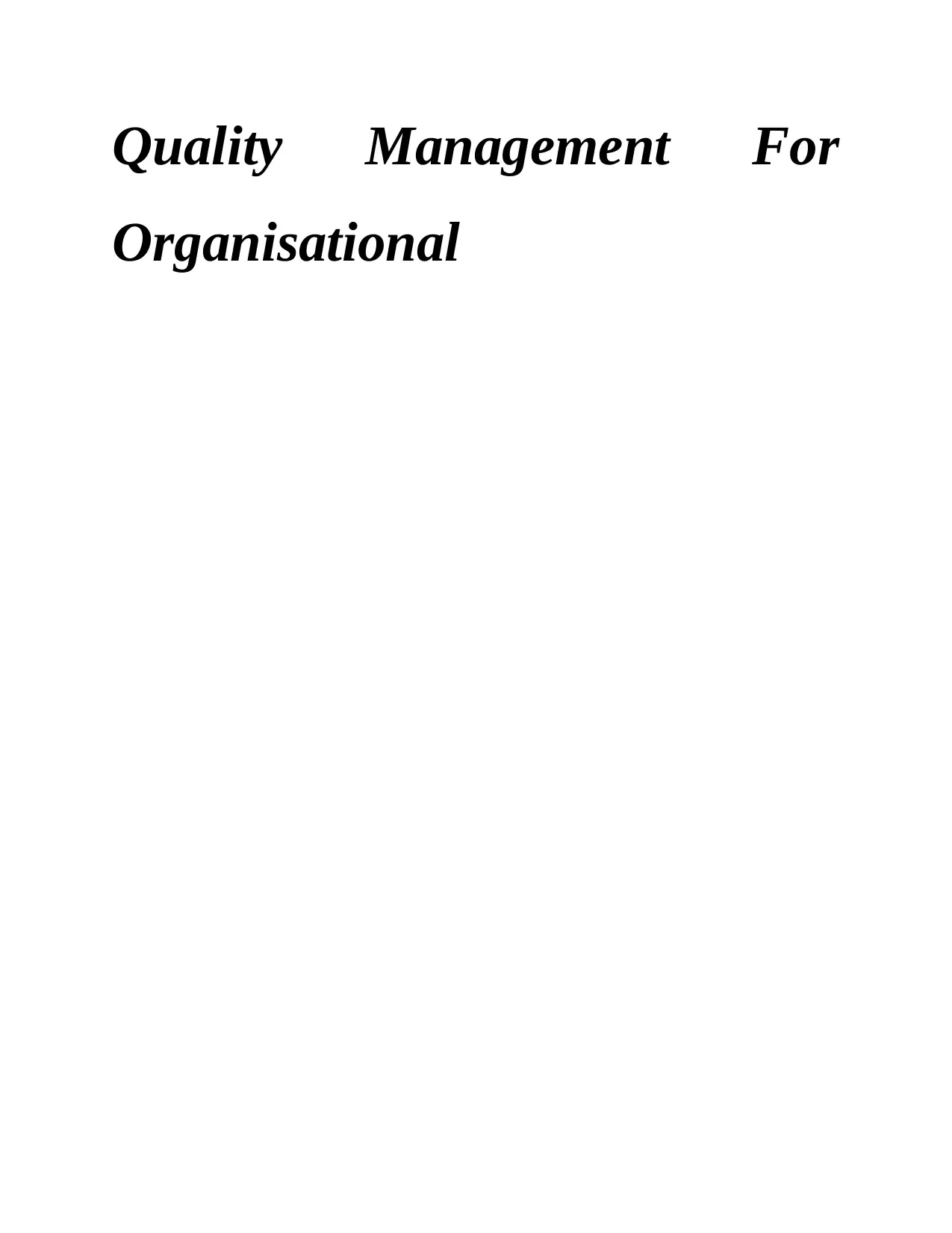
Quality Management For
Organisational
Organisational
Paraphrase This Document
Need a fresh take? Get an instant paraphrase of this document with our AI Paraphraser
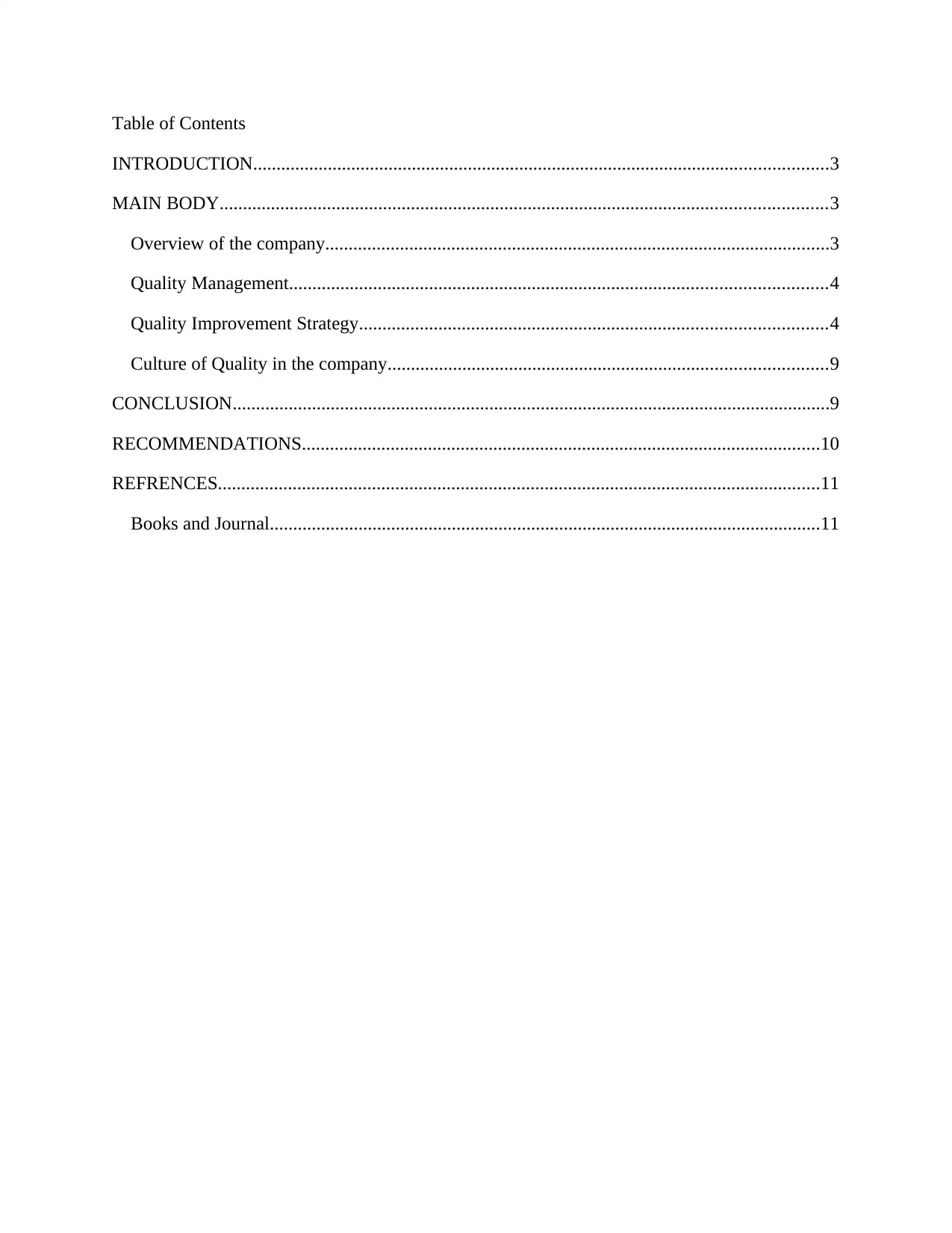
Table of Contents
INTRODUCTION...........................................................................................................................3
MAIN BODY..................................................................................................................................3
Overview of the company............................................................................................................3
Quality Management...................................................................................................................4
Quality Improvement Strategy....................................................................................................4
Culture of Quality in the company..............................................................................................9
CONCLUSION................................................................................................................................9
RECOMMENDATIONS...............................................................................................................10
REFRENCES.................................................................................................................................11
Books and Journal......................................................................................................................11
INTRODUCTION...........................................................................................................................3
MAIN BODY..................................................................................................................................3
Overview of the company............................................................................................................3
Quality Management...................................................................................................................4
Quality Improvement Strategy....................................................................................................4
Culture of Quality in the company..............................................................................................9
CONCLUSION................................................................................................................................9
RECOMMENDATIONS...............................................................................................................10
REFRENCES.................................................................................................................................11
Books and Journal......................................................................................................................11
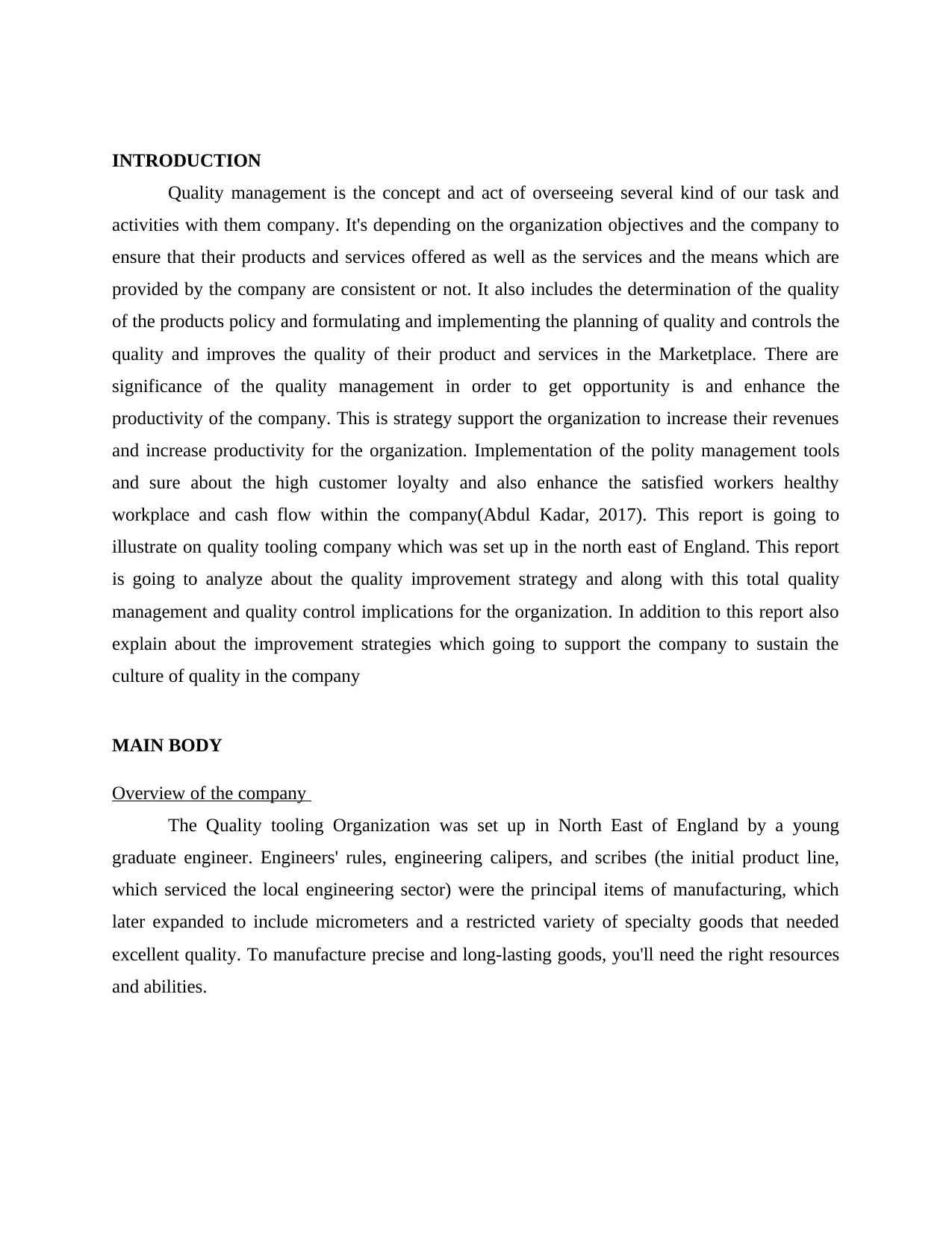
INTRODUCTION
Quality management is the concept and act of overseeing several kind of our task and
activities with them company. It's depending on the organization objectives and the company to
ensure that their products and services offered as well as the services and the means which are
provided by the company are consistent or not. It also includes the determination of the quality
of the products policy and formulating and implementing the planning of quality and controls the
quality and improves the quality of their product and services in the Marketplace. There are
significance of the quality management in order to get opportunity is and enhance the
productivity of the company. This is strategy support the organization to increase their revenues
and increase productivity for the organization. Implementation of the polity management tools
and sure about the high customer loyalty and also enhance the satisfied workers healthy
workplace and cash flow within the company(Abdul Kadar, 2017). This report is going to
illustrate on quality tooling company which was set up in the north east of England. This report
is going to analyze about the quality improvement strategy and along with this total quality
management and quality control implications for the organization. In addition to this report also
explain about the improvement strategies which going to support the company to sustain the
culture of quality in the company
MAIN BODY
Overview of the company
The Quality tooling Organization was set up in North East of England by a young
graduate engineer. Engineers' rules, engineering calipers, and scribes (the initial product line,
which serviced the local engineering sector) were the principal items of manufacturing, which
later expanded to include micrometers and a restricted variety of specialty goods that needed
excellent quality. To manufacture precise and long-lasting goods, you'll need the right resources
and abilities.
Quality management is the concept and act of overseeing several kind of our task and
activities with them company. It's depending on the organization objectives and the company to
ensure that their products and services offered as well as the services and the means which are
provided by the company are consistent or not. It also includes the determination of the quality
of the products policy and formulating and implementing the planning of quality and controls the
quality and improves the quality of their product and services in the Marketplace. There are
significance of the quality management in order to get opportunity is and enhance the
productivity of the company. This is strategy support the organization to increase their revenues
and increase productivity for the organization. Implementation of the polity management tools
and sure about the high customer loyalty and also enhance the satisfied workers healthy
workplace and cash flow within the company(Abdul Kadar, 2017). This report is going to
illustrate on quality tooling company which was set up in the north east of England. This report
is going to analyze about the quality improvement strategy and along with this total quality
management and quality control implications for the organization. In addition to this report also
explain about the improvement strategies which going to support the company to sustain the
culture of quality in the company
MAIN BODY
Overview of the company
The Quality tooling Organization was set up in North East of England by a young
graduate engineer. Engineers' rules, engineering calipers, and scribes (the initial product line,
which serviced the local engineering sector) were the principal items of manufacturing, which
later expanded to include micrometers and a restricted variety of specialty goods that needed
excellent quality. To manufacture precise and long-lasting goods, you'll need the right resources
and abilities.
⊘ This is a preview!⊘
Do you want full access?
Subscribe today to unlock all pages.

Trusted by 1+ million students worldwide
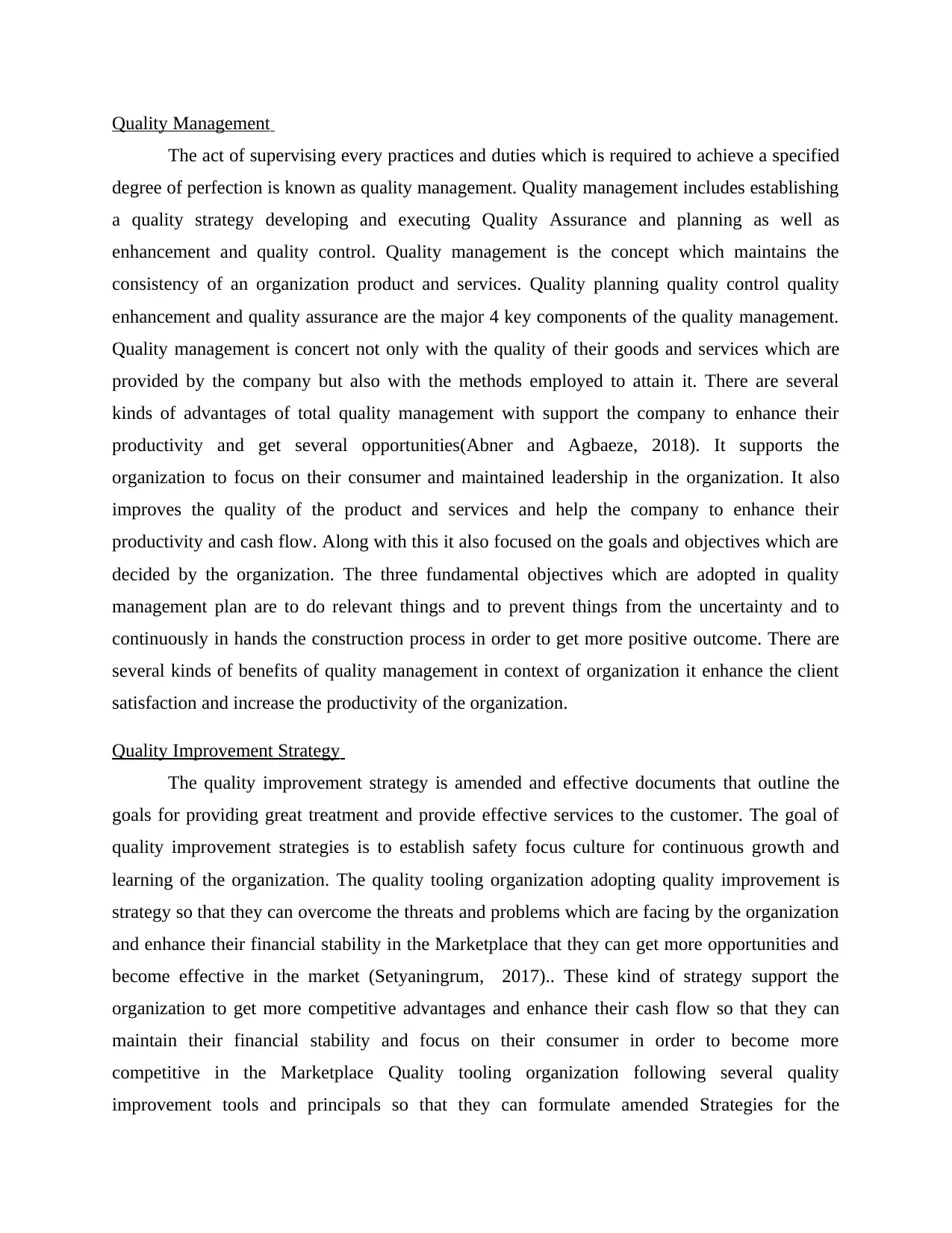
Quality Management
The act of supervising every practices and duties which is required to achieve a specified
degree of perfection is known as quality management. Quality management includes establishing
a quality strategy developing and executing Quality Assurance and planning as well as
enhancement and quality control. Quality management is the concept which maintains the
consistency of an organization product and services. Quality planning quality control quality
enhancement and quality assurance are the major 4 key components of the quality management.
Quality management is concert not only with the quality of their goods and services which are
provided by the company but also with the methods employed to attain it. There are several
kinds of advantages of total quality management with support the company to enhance their
productivity and get several opportunities(Abner and Agbaeze, 2018). It supports the
organization to focus on their consumer and maintained leadership in the organization. It also
improves the quality of the product and services and help the company to enhance their
productivity and cash flow. Along with this it also focused on the goals and objectives which are
decided by the organization. The three fundamental objectives which are adopted in quality
management plan are to do relevant things and to prevent things from the uncertainty and to
continuously in hands the construction process in order to get more positive outcome. There are
several kinds of benefits of quality management in context of organization it enhance the client
satisfaction and increase the productivity of the organization.
Quality Improvement Strategy
The quality improvement strategy is amended and effective documents that outline the
goals for providing great treatment and provide effective services to the customer. The goal of
quality improvement strategies is to establish safety focus culture for continuous growth and
learning of the organization. The quality tooling organization adopting quality improvement is
strategy so that they can overcome the threats and problems which are facing by the organization
and enhance their financial stability in the Marketplace that they can get more opportunities and
become effective in the market (Setyaningrum, 2017).. These kind of strategy support the
organization to get more competitive advantages and enhance their cash flow so that they can
maintain their financial stability and focus on their consumer in order to become more
competitive in the Marketplace Quality tooling organization following several quality
improvement tools and principals so that they can formulate amended Strategies for the
The act of supervising every practices and duties which is required to achieve a specified
degree of perfection is known as quality management. Quality management includes establishing
a quality strategy developing and executing Quality Assurance and planning as well as
enhancement and quality control. Quality management is the concept which maintains the
consistency of an organization product and services. Quality planning quality control quality
enhancement and quality assurance are the major 4 key components of the quality management.
Quality management is concert not only with the quality of their goods and services which are
provided by the company but also with the methods employed to attain it. There are several
kinds of advantages of total quality management with support the company to enhance their
productivity and get several opportunities(Abner and Agbaeze, 2018). It supports the
organization to focus on their consumer and maintained leadership in the organization. It also
improves the quality of the product and services and help the company to enhance their
productivity and cash flow. Along with this it also focused on the goals and objectives which are
decided by the organization. The three fundamental objectives which are adopted in quality
management plan are to do relevant things and to prevent things from the uncertainty and to
continuously in hands the construction process in order to get more positive outcome. There are
several kinds of benefits of quality management in context of organization it enhance the client
satisfaction and increase the productivity of the organization.
Quality Improvement Strategy
The quality improvement strategy is amended and effective documents that outline the
goals for providing great treatment and provide effective services to the customer. The goal of
quality improvement strategies is to establish safety focus culture for continuous growth and
learning of the organization. The quality tooling organization adopting quality improvement is
strategy so that they can overcome the threats and problems which are facing by the organization
and enhance their financial stability in the Marketplace that they can get more opportunities and
become effective in the market (Setyaningrum, 2017).. These kind of strategy support the
organization to get more competitive advantages and enhance their cash flow so that they can
maintain their financial stability and focus on their consumer in order to become more
competitive in the Marketplace Quality tooling organization following several quality
improvement tools and principals so that they can formulate amended Strategies for the
Paraphrase This Document
Need a fresh take? Get an instant paraphrase of this document with our AI Paraphraser
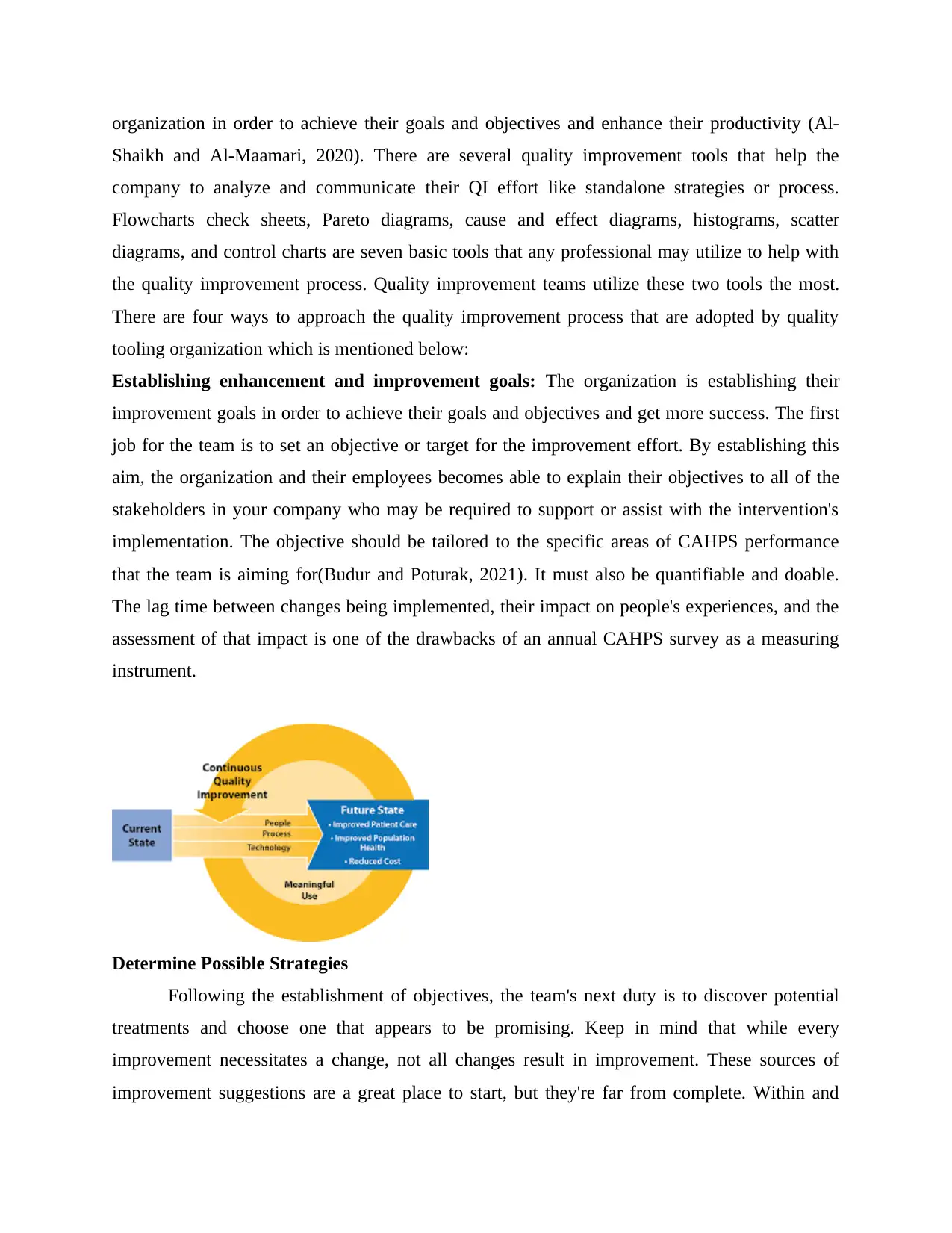
organization in order to achieve their goals and objectives and enhance their productivity (Al-
Shaikh and Al-Maamari, 2020). There are several quality improvement tools that help the
company to analyze and communicate their QI effort like standalone strategies or process.
Flowcharts check sheets, Pareto diagrams, cause and effect diagrams, histograms, scatter
diagrams, and control charts are seven basic tools that any professional may utilize to help with
the quality improvement process. Quality improvement teams utilize these two tools the most.
There are four ways to approach the quality improvement process that are adopted by quality
tooling organization which is mentioned below:
Establishing enhancement and improvement goals: The organization is establishing their
improvement goals in order to achieve their goals and objectives and get more success. The first
job for the team is to set an objective or target for the improvement effort. By establishing this
aim, the organization and their employees becomes able to explain their objectives to all of the
stakeholders in your company who may be required to support or assist with the intervention's
implementation. The objective should be tailored to the specific areas of CAHPS performance
that the team is aiming for(Budur and Poturak, 2021). It must also be quantifiable and doable.
The lag time between changes being implemented, their impact on people's experiences, and the
assessment of that impact is one of the drawbacks of an annual CAHPS survey as a measuring
instrument.
Determine Possible Strategies
Following the establishment of objectives, the team's next duty is to discover potential
treatments and choose one that appears to be promising. Keep in mind that while every
improvement necessitates a change, not all changes result in improvement. These sources of
improvement suggestions are a great place to start, but they're far from complete. Within and
Shaikh and Al-Maamari, 2020). There are several quality improvement tools that help the
company to analyze and communicate their QI effort like standalone strategies or process.
Flowcharts check sheets, Pareto diagrams, cause and effect diagrams, histograms, scatter
diagrams, and control charts are seven basic tools that any professional may utilize to help with
the quality improvement process. Quality improvement teams utilize these two tools the most.
There are four ways to approach the quality improvement process that are adopted by quality
tooling organization which is mentioned below:
Establishing enhancement and improvement goals: The organization is establishing their
improvement goals in order to achieve their goals and objectives and get more success. The first
job for the team is to set an objective or target for the improvement effort. By establishing this
aim, the organization and their employees becomes able to explain their objectives to all of the
stakeholders in your company who may be required to support or assist with the intervention's
implementation. The objective should be tailored to the specific areas of CAHPS performance
that the team is aiming for(Budur and Poturak, 2021). It must also be quantifiable and doable.
The lag time between changes being implemented, their impact on people's experiences, and the
assessment of that impact is one of the drawbacks of an annual CAHPS survey as a measuring
instrument.
Determine Possible Strategies
Following the establishment of objectives, the team's next duty is to discover potential
treatments and choose one that appears to be promising. Keep in mind that while every
improvement necessitates a change, not all changes result in improvement. These sources of
improvement suggestions are a great place to start, but they're far from complete. Within and
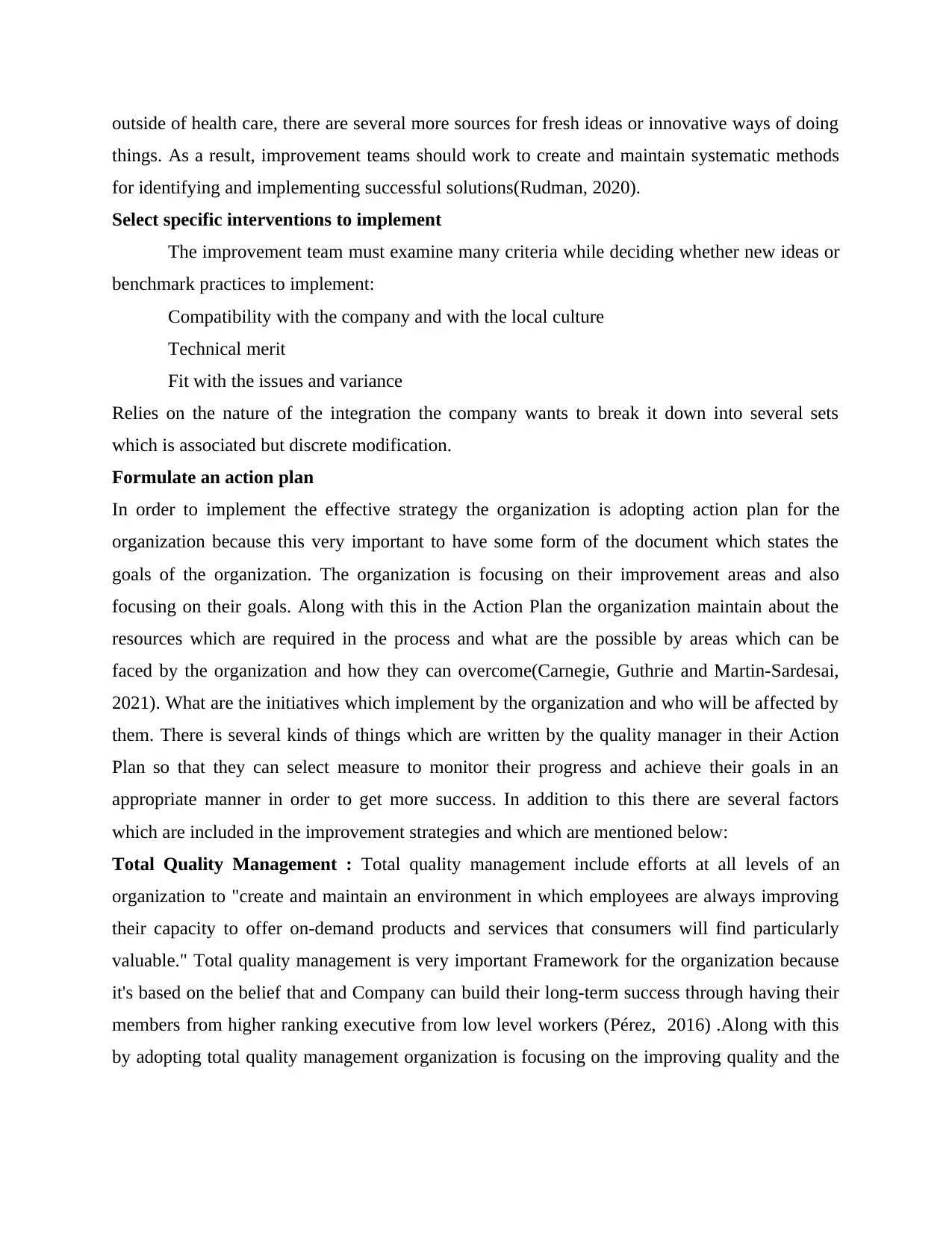
outside of health care, there are several more sources for fresh ideas or innovative ways of doing
things. As a result, improvement teams should work to create and maintain systematic methods
for identifying and implementing successful solutions(Rudman, 2020).
Select specific interventions to implement
The improvement team must examine many criteria while deciding whether new ideas or
benchmark practices to implement:
Compatibility with the company and with the local culture
Technical merit
Fit with the issues and variance
Relies on the nature of the integration the company wants to break it down into several sets
which is associated but discrete modification.
Formulate an action plan
In order to implement the effective strategy the organization is adopting action plan for the
organization because this very important to have some form of the document which states the
goals of the organization. The organization is focusing on their improvement areas and also
focusing on their goals. Along with this in the Action Plan the organization maintain about the
resources which are required in the process and what are the possible by areas which can be
faced by the organization and how they can overcome(Carnegie, Guthrie and Martin-Sardesai,
2021). What are the initiatives which implement by the organization and who will be affected by
them. There is several kinds of things which are written by the quality manager in their Action
Plan so that they can select measure to monitor their progress and achieve their goals in an
appropriate manner in order to get more success. In addition to this there are several factors
which are included in the improvement strategies and which are mentioned below:
Total Quality Management : Total quality management include efforts at all levels of an
organization to "create and maintain an environment in which employees are always improving
their capacity to offer on-demand products and services that consumers will find particularly
valuable." Total quality management is very important Framework for the organization because
it's based on the belief that and Company can build their long-term success through having their
members from higher ranking executive from low level workers (Pérez, 2016) .Along with this
by adopting total quality management organization is focusing on the improving quality and the
things. As a result, improvement teams should work to create and maintain systematic methods
for identifying and implementing successful solutions(Rudman, 2020).
Select specific interventions to implement
The improvement team must examine many criteria while deciding whether new ideas or
benchmark practices to implement:
Compatibility with the company and with the local culture
Technical merit
Fit with the issues and variance
Relies on the nature of the integration the company wants to break it down into several sets
which is associated but discrete modification.
Formulate an action plan
In order to implement the effective strategy the organization is adopting action plan for the
organization because this very important to have some form of the document which states the
goals of the organization. The organization is focusing on their improvement areas and also
focusing on their goals. Along with this in the Action Plan the organization maintain about the
resources which are required in the process and what are the possible by areas which can be
faced by the organization and how they can overcome(Carnegie, Guthrie and Martin-Sardesai,
2021). What are the initiatives which implement by the organization and who will be affected by
them. There is several kinds of things which are written by the quality manager in their Action
Plan so that they can select measure to monitor their progress and achieve their goals in an
appropriate manner in order to get more success. In addition to this there are several factors
which are included in the improvement strategies and which are mentioned below:
Total Quality Management : Total quality management include efforts at all levels of an
organization to "create and maintain an environment in which employees are always improving
their capacity to offer on-demand products and services that consumers will find particularly
valuable." Total quality management is very important Framework for the organization because
it's based on the belief that and Company can build their long-term success through having their
members from higher ranking executive from low level workers (Pérez, 2016) .Along with this
by adopting total quality management organization is focusing on the improving quality and the
⊘ This is a preview!⊘
Do you want full access?
Subscribe today to unlock all pages.

Trusted by 1+ million students worldwide
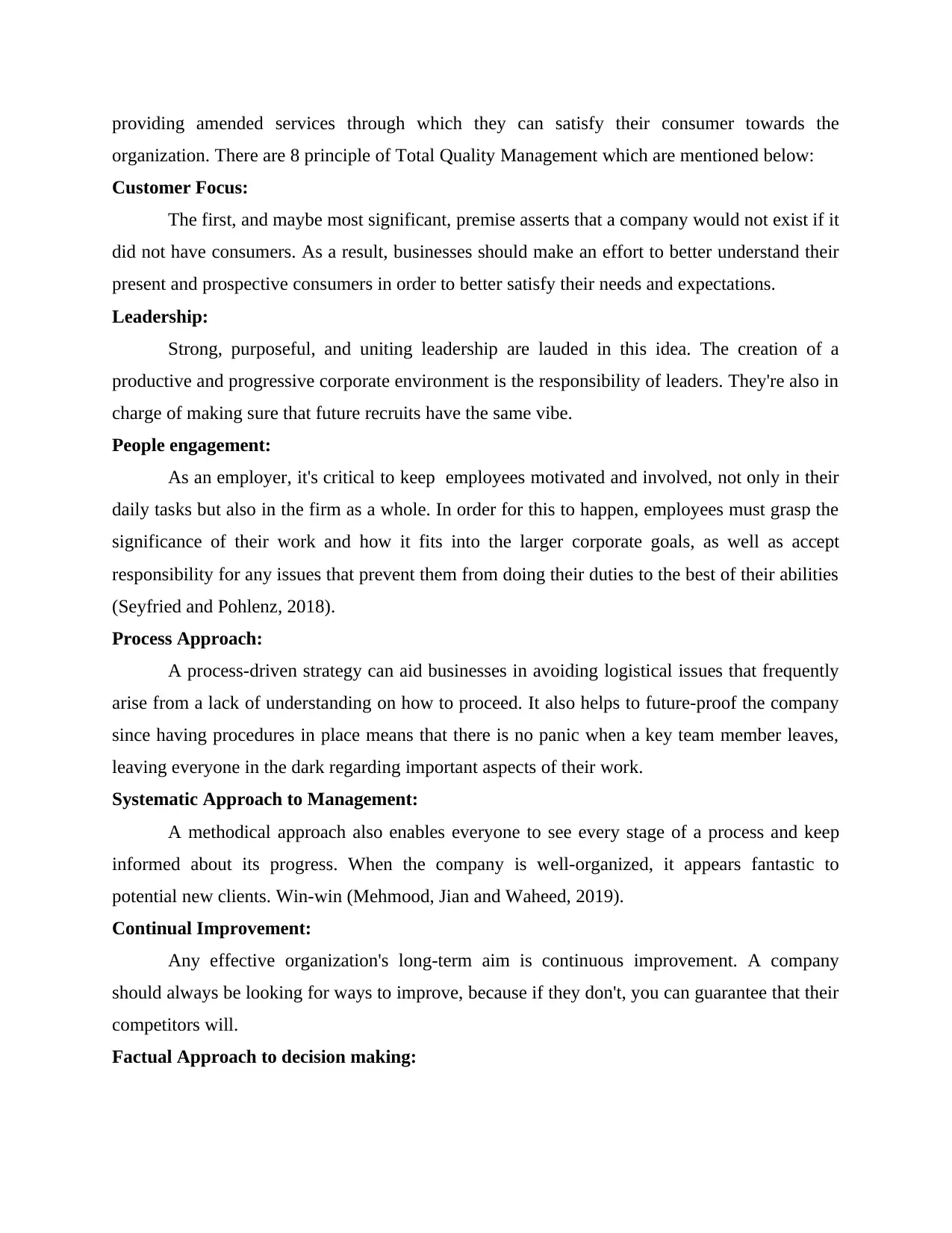
providing amended services through which they can satisfy their consumer towards the
organization. There are 8 principle of Total Quality Management which are mentioned below:
Customer Focus:
The first, and maybe most significant, premise asserts that a company would not exist if it
did not have consumers. As a result, businesses should make an effort to better understand their
present and prospective consumers in order to better satisfy their needs and expectations.
Leadership:
Strong, purposeful, and uniting leadership are lauded in this idea. The creation of a
productive and progressive corporate environment is the responsibility of leaders. They're also in
charge of making sure that future recruits have the same vibe.
People engagement:
As an employer, it's critical to keep employees motivated and involved, not only in their
daily tasks but also in the firm as a whole. In order for this to happen, employees must grasp the
significance of their work and how it fits into the larger corporate goals, as well as accept
responsibility for any issues that prevent them from doing their duties to the best of their abilities
(Seyfried and Pohlenz, 2018).
Process Approach:
A process-driven strategy can aid businesses in avoiding logistical issues that frequently
arise from a lack of understanding on how to proceed. It also helps to future-proof the company
since having procedures in place means that there is no panic when a key team member leaves,
leaving everyone in the dark regarding important aspects of their work.
Systematic Approach to Management:
A methodical approach also enables everyone to see every stage of a process and keep
informed about its progress. When the company is well-organized, it appears fantastic to
potential new clients. Win-win (Mehmood, Jian and Waheed, 2019).
Continual Improvement:
Any effective organization's long-term aim is continuous improvement. A company
should always be looking for ways to improve, because if they don't, you can guarantee that their
competitors will.
Factual Approach to decision making:
organization. There are 8 principle of Total Quality Management which are mentioned below:
Customer Focus:
The first, and maybe most significant, premise asserts that a company would not exist if it
did not have consumers. As a result, businesses should make an effort to better understand their
present and prospective consumers in order to better satisfy their needs and expectations.
Leadership:
Strong, purposeful, and uniting leadership are lauded in this idea. The creation of a
productive and progressive corporate environment is the responsibility of leaders. They're also in
charge of making sure that future recruits have the same vibe.
People engagement:
As an employer, it's critical to keep employees motivated and involved, not only in their
daily tasks but also in the firm as a whole. In order for this to happen, employees must grasp the
significance of their work and how it fits into the larger corporate goals, as well as accept
responsibility for any issues that prevent them from doing their duties to the best of their abilities
(Seyfried and Pohlenz, 2018).
Process Approach:
A process-driven strategy can aid businesses in avoiding logistical issues that frequently
arise from a lack of understanding on how to proceed. It also helps to future-proof the company
since having procedures in place means that there is no panic when a key team member leaves,
leaving everyone in the dark regarding important aspects of their work.
Systematic Approach to Management:
A methodical approach also enables everyone to see every stage of a process and keep
informed about its progress. When the company is well-organized, it appears fantastic to
potential new clients. Win-win (Mehmood, Jian and Waheed, 2019).
Continual Improvement:
Any effective organization's long-term aim is continuous improvement. A company
should always be looking for ways to improve, because if they don't, you can guarantee that their
competitors will.
Factual Approach to decision making:
Paraphrase This Document
Need a fresh take? Get an instant paraphrase of this document with our AI Paraphraser
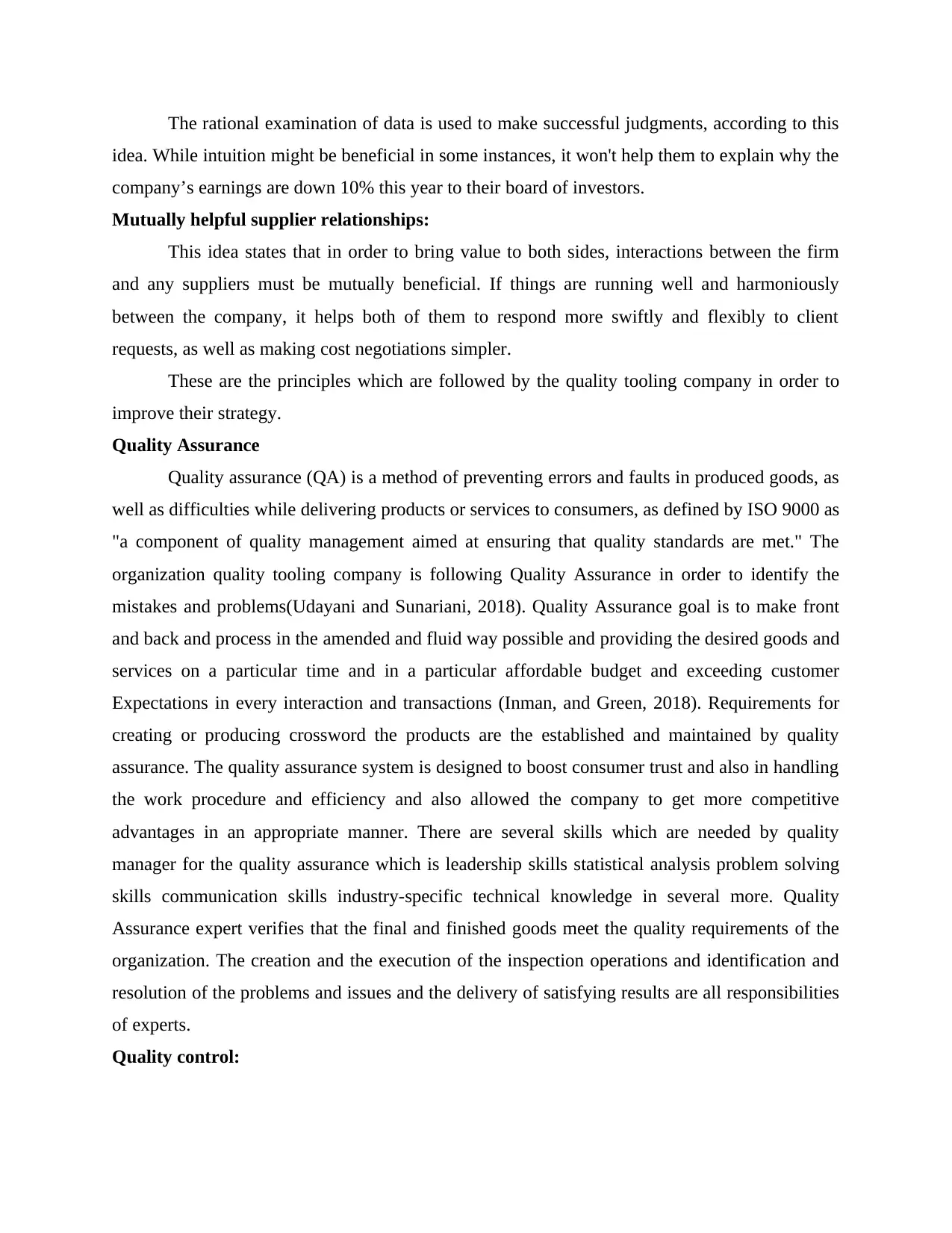
The rational examination of data is used to make successful judgments, according to this
idea. While intuition might be beneficial in some instances, it won't help them to explain why the
company’s earnings are down 10% this year to their board of investors.
Mutually helpful supplier relationships:
This idea states that in order to bring value to both sides, interactions between the firm
and any suppliers must be mutually beneficial. If things are running well and harmoniously
between the company, it helps both of them to respond more swiftly and flexibly to client
requests, as well as making cost negotiations simpler.
These are the principles which are followed by the quality tooling company in order to
improve their strategy.
Quality Assurance
Quality assurance (QA) is a method of preventing errors and faults in produced goods, as
well as difficulties while delivering products or services to consumers, as defined by ISO 9000 as
"a component of quality management aimed at ensuring that quality standards are met." The
organization quality tooling company is following Quality Assurance in order to identify the
mistakes and problems(Udayani and Sunariani, 2018). Quality Assurance goal is to make front
and back and process in the amended and fluid way possible and providing the desired goods and
services on a particular time and in a particular affordable budget and exceeding customer
Expectations in every interaction and transactions (Inman, and Green, 2018). Requirements for
creating or producing crossword the products are the established and maintained by quality
assurance. The quality assurance system is designed to boost consumer trust and also in handling
the work procedure and efficiency and also allowed the company to get more competitive
advantages in an appropriate manner. There are several skills which are needed by quality
manager for the quality assurance which is leadership skills statistical analysis problem solving
skills communication skills industry-specific technical knowledge in several more. Quality
Assurance expert verifies that the final and finished goods meet the quality requirements of the
organization. The creation and the execution of the inspection operations and identification and
resolution of the problems and issues and the delivery of satisfying results are all responsibilities
of experts.
Quality control:
idea. While intuition might be beneficial in some instances, it won't help them to explain why the
company’s earnings are down 10% this year to their board of investors.
Mutually helpful supplier relationships:
This idea states that in order to bring value to both sides, interactions between the firm
and any suppliers must be mutually beneficial. If things are running well and harmoniously
between the company, it helps both of them to respond more swiftly and flexibly to client
requests, as well as making cost negotiations simpler.
These are the principles which are followed by the quality tooling company in order to
improve their strategy.
Quality Assurance
Quality assurance (QA) is a method of preventing errors and faults in produced goods, as
well as difficulties while delivering products or services to consumers, as defined by ISO 9000 as
"a component of quality management aimed at ensuring that quality standards are met." The
organization quality tooling company is following Quality Assurance in order to identify the
mistakes and problems(Udayani and Sunariani, 2018). Quality Assurance goal is to make front
and back and process in the amended and fluid way possible and providing the desired goods and
services on a particular time and in a particular affordable budget and exceeding customer
Expectations in every interaction and transactions (Inman, and Green, 2018). Requirements for
creating or producing crossword the products are the established and maintained by quality
assurance. The quality assurance system is designed to boost consumer trust and also in handling
the work procedure and efficiency and also allowed the company to get more competitive
advantages in an appropriate manner. There are several skills which are needed by quality
manager for the quality assurance which is leadership skills statistical analysis problem solving
skills communication skills industry-specific technical knowledge in several more. Quality
Assurance expert verifies that the final and finished goods meet the quality requirements of the
organization. The creation and the execution of the inspection operations and identification and
resolution of the problems and issues and the delivery of satisfying results are all responsibilities
of experts.
Quality control:
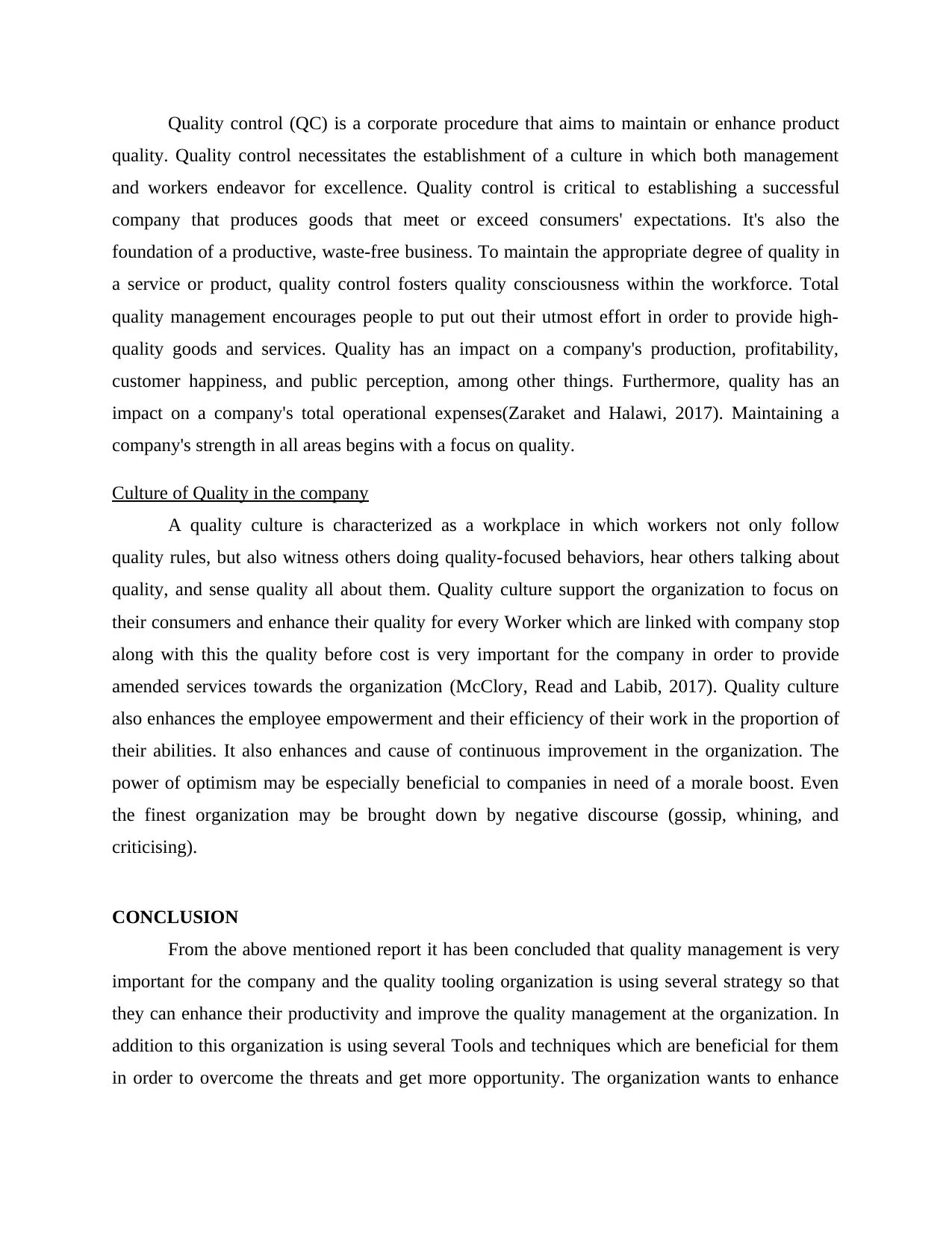
Quality control (QC) is a corporate procedure that aims to maintain or enhance product
quality. Quality control necessitates the establishment of a culture in which both management
and workers endeavor for excellence. Quality control is critical to establishing a successful
company that produces goods that meet or exceed consumers' expectations. It's also the
foundation of a productive, waste-free business. To maintain the appropriate degree of quality in
a service or product, quality control fosters quality consciousness within the workforce. Total
quality management encourages people to put out their utmost effort in order to provide high-
quality goods and services. Quality has an impact on a company's production, profitability,
customer happiness, and public perception, among other things. Furthermore, quality has an
impact on a company's total operational expenses(Zaraket and Halawi, 2017). Maintaining a
company's strength in all areas begins with a focus on quality.
Culture of Quality in the company
A quality culture is characterized as a workplace in which workers not only follow
quality rules, but also witness others doing quality-focused behaviors, hear others talking about
quality, and sense quality all about them. Quality culture support the organization to focus on
their consumers and enhance their quality for every Worker which are linked with company stop
along with this the quality before cost is very important for the company in order to provide
amended services towards the organization (McClory, Read and Labib, 2017). Quality culture
also enhances the employee empowerment and their efficiency of their work in the proportion of
their abilities. It also enhances and cause of continuous improvement in the organization. The
power of optimism may be especially beneficial to companies in need of a morale boost. Even
the finest organization may be brought down by negative discourse (gossip, whining, and
criticising).
CONCLUSION
From the above mentioned report it has been concluded that quality management is very
important for the company and the quality tooling organization is using several strategy so that
they can enhance their productivity and improve the quality management at the organization. In
addition to this organization is using several Tools and techniques which are beneficial for them
in order to overcome the threats and get more opportunity. The organization wants to enhance
quality. Quality control necessitates the establishment of a culture in which both management
and workers endeavor for excellence. Quality control is critical to establishing a successful
company that produces goods that meet or exceed consumers' expectations. It's also the
foundation of a productive, waste-free business. To maintain the appropriate degree of quality in
a service or product, quality control fosters quality consciousness within the workforce. Total
quality management encourages people to put out their utmost effort in order to provide high-
quality goods and services. Quality has an impact on a company's production, profitability,
customer happiness, and public perception, among other things. Furthermore, quality has an
impact on a company's total operational expenses(Zaraket and Halawi, 2017). Maintaining a
company's strength in all areas begins with a focus on quality.
Culture of Quality in the company
A quality culture is characterized as a workplace in which workers not only follow
quality rules, but also witness others doing quality-focused behaviors, hear others talking about
quality, and sense quality all about them. Quality culture support the organization to focus on
their consumers and enhance their quality for every Worker which are linked with company stop
along with this the quality before cost is very important for the company in order to provide
amended services towards the organization (McClory, Read and Labib, 2017). Quality culture
also enhances the employee empowerment and their efficiency of their work in the proportion of
their abilities. It also enhances and cause of continuous improvement in the organization. The
power of optimism may be especially beneficial to companies in need of a morale boost. Even
the finest organization may be brought down by negative discourse (gossip, whining, and
criticising).
CONCLUSION
From the above mentioned report it has been concluded that quality management is very
important for the company and the quality tooling organization is using several strategy so that
they can enhance their productivity and improve the quality management at the organization. In
addition to this organization is using several Tools and techniques which are beneficial for them
in order to overcome the threats and get more opportunity. The organization wants to enhance
⊘ This is a preview!⊘
Do you want full access?
Subscribe today to unlock all pages.

Trusted by 1+ million students worldwide
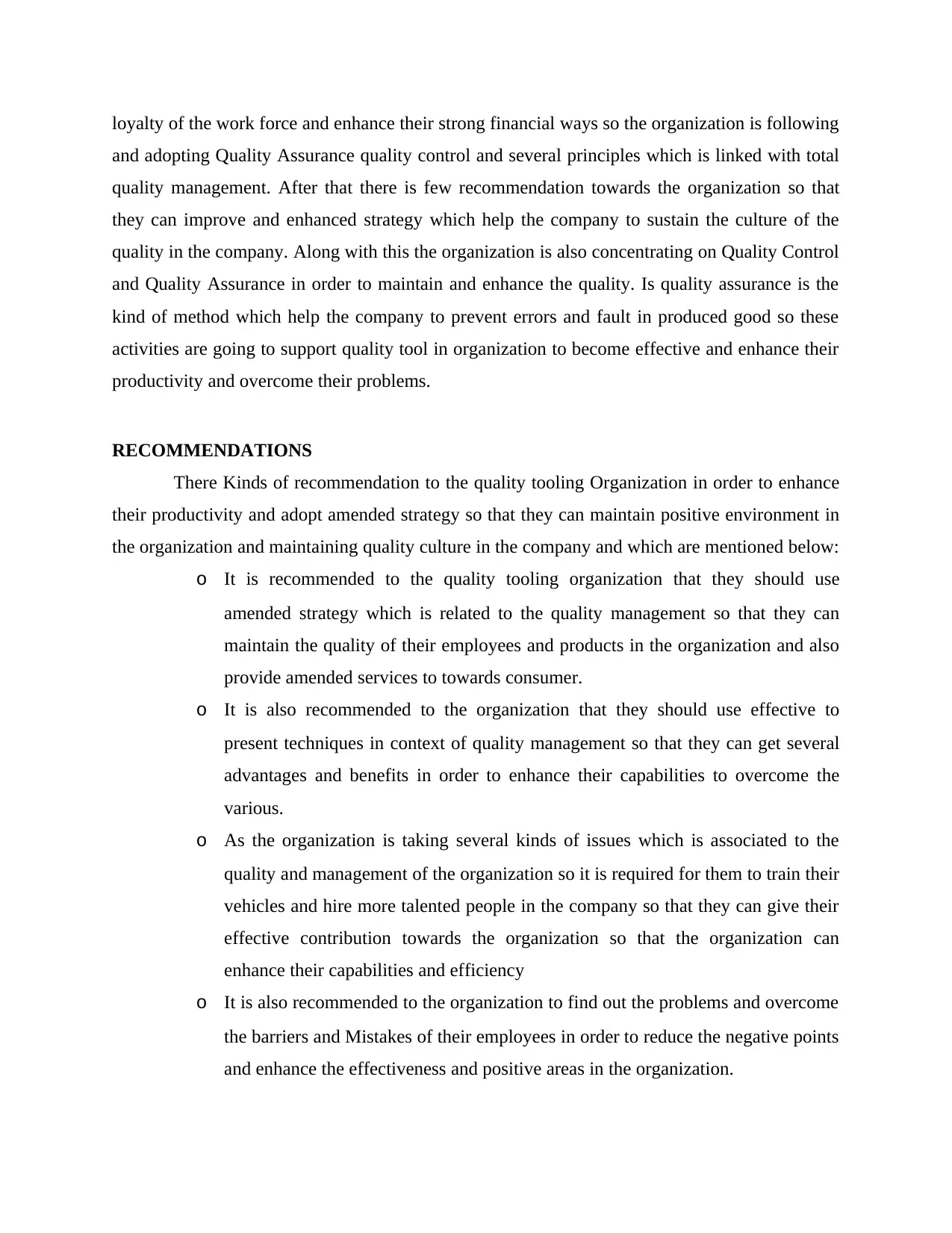
loyalty of the work force and enhance their strong financial ways so the organization is following
and adopting Quality Assurance quality control and several principles which is linked with total
quality management. After that there is few recommendation towards the organization so that
they can improve and enhanced strategy which help the company to sustain the culture of the
quality in the company. Along with this the organization is also concentrating on Quality Control
and Quality Assurance in order to maintain and enhance the quality. Is quality assurance is the
kind of method which help the company to prevent errors and fault in produced good so these
activities are going to support quality tool in organization to become effective and enhance their
productivity and overcome their problems.
RECOMMENDATIONS
There Kinds of recommendation to the quality tooling Organization in order to enhance
their productivity and adopt amended strategy so that they can maintain positive environment in
the organization and maintaining quality culture in the company and which are mentioned below:
o It is recommended to the quality tooling organization that they should use
amended strategy which is related to the quality management so that they can
maintain the quality of their employees and products in the organization and also
provide amended services to towards consumer.
o It is also recommended to the organization that they should use effective to
present techniques in context of quality management so that they can get several
advantages and benefits in order to enhance their capabilities to overcome the
various.
o As the organization is taking several kinds of issues which is associated to the
quality and management of the organization so it is required for them to train their
vehicles and hire more talented people in the company so that they can give their
effective contribution towards the organization so that the organization can
enhance their capabilities and efficiency
o It is also recommended to the organization to find out the problems and overcome
the barriers and Mistakes of their employees in order to reduce the negative points
and enhance the effectiveness and positive areas in the organization.
and adopting Quality Assurance quality control and several principles which is linked with total
quality management. After that there is few recommendation towards the organization so that
they can improve and enhanced strategy which help the company to sustain the culture of the
quality in the company. Along with this the organization is also concentrating on Quality Control
and Quality Assurance in order to maintain and enhance the quality. Is quality assurance is the
kind of method which help the company to prevent errors and fault in produced good so these
activities are going to support quality tool in organization to become effective and enhance their
productivity and overcome their problems.
RECOMMENDATIONS
There Kinds of recommendation to the quality tooling Organization in order to enhance
their productivity and adopt amended strategy so that they can maintain positive environment in
the organization and maintaining quality culture in the company and which are mentioned below:
o It is recommended to the quality tooling organization that they should use
amended strategy which is related to the quality management so that they can
maintain the quality of their employees and products in the organization and also
provide amended services to towards consumer.
o It is also recommended to the organization that they should use effective to
present techniques in context of quality management so that they can get several
advantages and benefits in order to enhance their capabilities to overcome the
various.
o As the organization is taking several kinds of issues which is associated to the
quality and management of the organization so it is required for them to train their
vehicles and hire more talented people in the company so that they can give their
effective contribution towards the organization so that the organization can
enhance their capabilities and efficiency
o It is also recommended to the organization to find out the problems and overcome
the barriers and Mistakes of their employees in order to reduce the negative points
and enhance the effectiveness and positive areas in the organization.
Paraphrase This Document
Need a fresh take? Get an instant paraphrase of this document with our AI Paraphraser
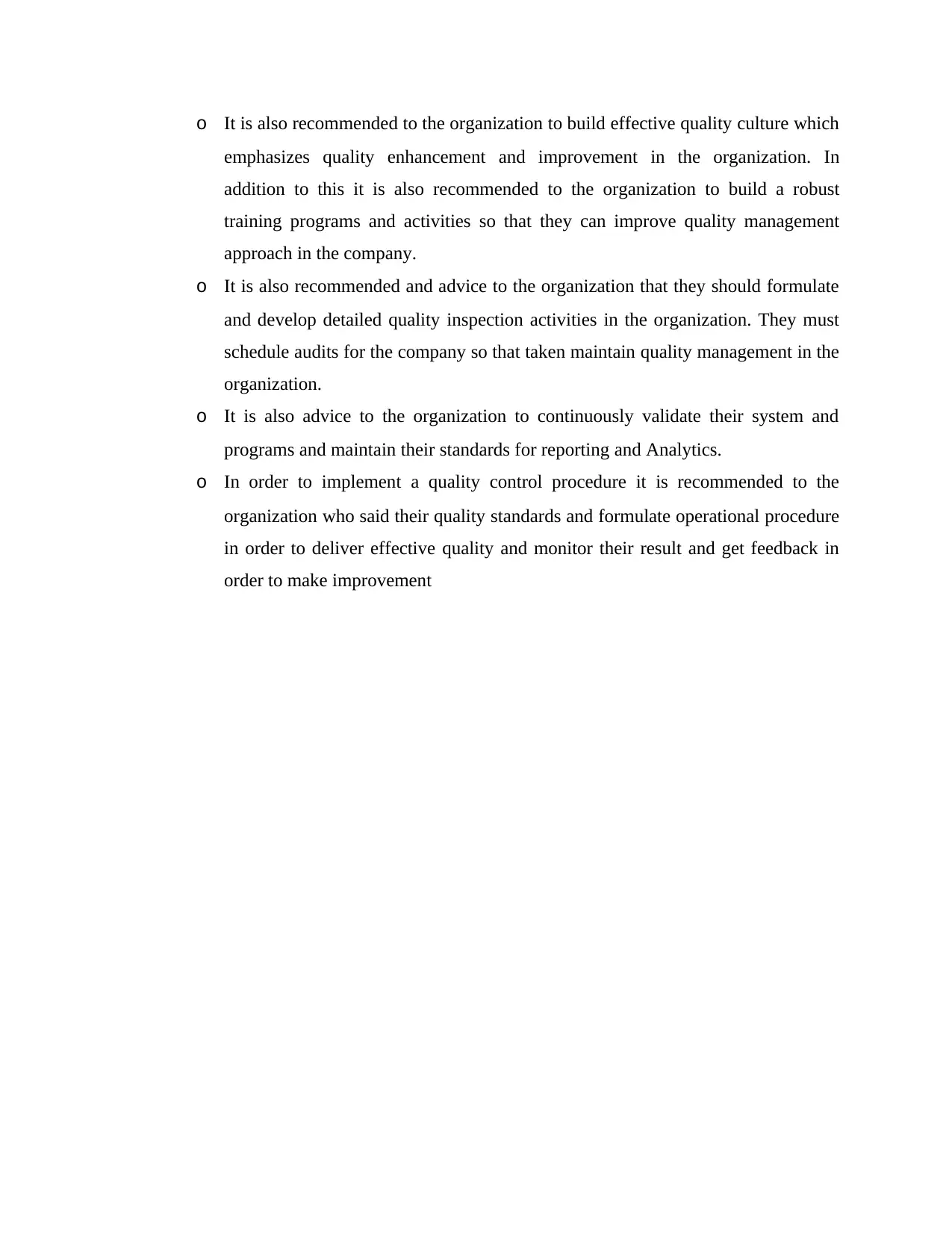
o It is also recommended to the organization to build effective quality culture which
emphasizes quality enhancement and improvement in the organization. In
addition to this it is also recommended to the organization to build a robust
training programs and activities so that they can improve quality management
approach in the company.
o It is also recommended and advice to the organization that they should formulate
and develop detailed quality inspection activities in the organization. They must
schedule audits for the company so that taken maintain quality management in the
organization.
o It is also advice to the organization to continuously validate their system and
programs and maintain their standards for reporting and Analytics.
o In order to implement a quality control procedure it is recommended to the
organization who said their quality standards and formulate operational procedure
in order to deliver effective quality and monitor their result and get feedback in
order to make improvement
emphasizes quality enhancement and improvement in the organization. In
addition to this it is also recommended to the organization to build a robust
training programs and activities so that they can improve quality management
approach in the company.
o It is also recommended and advice to the organization that they should formulate
and develop detailed quality inspection activities in the organization. They must
schedule audits for the company so that taken maintain quality management in the
organization.
o It is also advice to the organization to continuously validate their system and
programs and maintain their standards for reporting and Analytics.
o In order to implement a quality control procedure it is recommended to the
organization who said their quality standards and formulate operational procedure
in order to deliver effective quality and monitor their result and get feedback in
order to make improvement
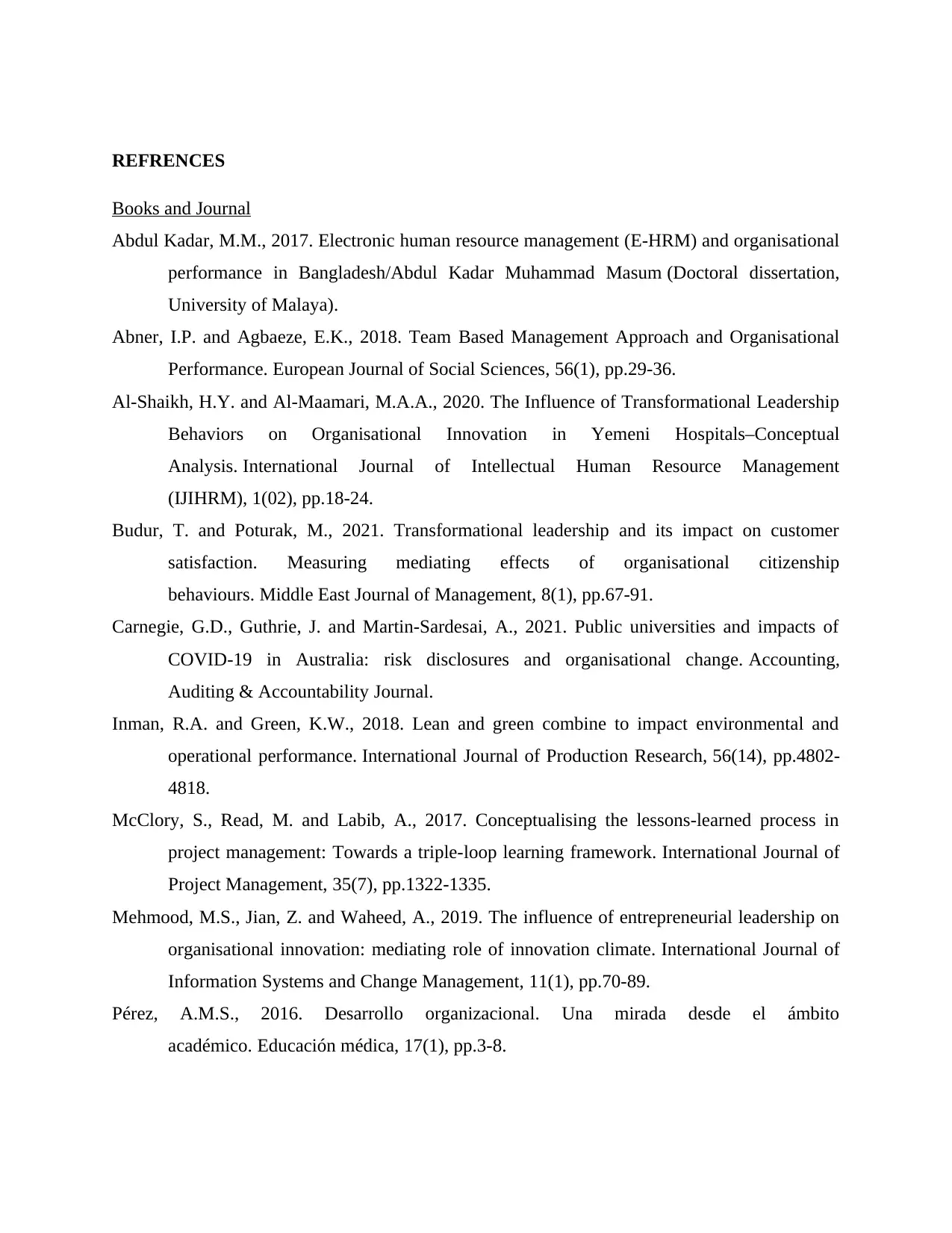
REFRENCES
Books and Journal
Abdul Kadar, M.M., 2017. Electronic human resource management (E-HRM) and organisational
performance in Bangladesh/Abdul Kadar Muhammad Masum (Doctoral dissertation,
University of Malaya).
Abner, I.P. and Agbaeze, E.K., 2018. Team Based Management Approach and Organisational
Performance. European Journal of Social Sciences, 56(1), pp.29-36.
Al-Shaikh, H.Y. and Al-Maamari, M.A.A., 2020. The Influence of Transformational Leadership
Behaviors on Organisational Innovation in Yemeni Hospitals–Conceptual
Analysis. International Journal of Intellectual Human Resource Management
(IJIHRM), 1(02), pp.18-24.
Budur, T. and Poturak, M., 2021. Transformational leadership and its impact on customer
satisfaction. Measuring mediating effects of organisational citizenship
behaviours. Middle East Journal of Management, 8(1), pp.67-91.
Carnegie, G.D., Guthrie, J. and Martin-Sardesai, A., 2021. Public universities and impacts of
COVID-19 in Australia: risk disclosures and organisational change. Accounting,
Auditing & Accountability Journal.
Inman, R.A. and Green, K.W., 2018. Lean and green combine to impact environmental and
operational performance. International Journal of Production Research, 56(14), pp.4802-
4818.
McClory, S., Read, M. and Labib, A., 2017. Conceptualising the lessons-learned process in
project management: Towards a triple-loop learning framework. International Journal of
Project Management, 35(7), pp.1322-1335.
Mehmood, M.S., Jian, Z. and Waheed, A., 2019. The influence of entrepreneurial leadership on
organisational innovation: mediating role of innovation climate. International Journal of
Information Systems and Change Management, 11(1), pp.70-89.
Pérez, A.M.S., 2016. Desarrollo organizacional. Una mirada desde el ámbito
académico. Educación médica, 17(1), pp.3-8.
Books and Journal
Abdul Kadar, M.M., 2017. Electronic human resource management (E-HRM) and organisational
performance in Bangladesh/Abdul Kadar Muhammad Masum (Doctoral dissertation,
University of Malaya).
Abner, I.P. and Agbaeze, E.K., 2018. Team Based Management Approach and Organisational
Performance. European Journal of Social Sciences, 56(1), pp.29-36.
Al-Shaikh, H.Y. and Al-Maamari, M.A.A., 2020. The Influence of Transformational Leadership
Behaviors on Organisational Innovation in Yemeni Hospitals–Conceptual
Analysis. International Journal of Intellectual Human Resource Management
(IJIHRM), 1(02), pp.18-24.
Budur, T. and Poturak, M., 2021. Transformational leadership and its impact on customer
satisfaction. Measuring mediating effects of organisational citizenship
behaviours. Middle East Journal of Management, 8(1), pp.67-91.
Carnegie, G.D., Guthrie, J. and Martin-Sardesai, A., 2021. Public universities and impacts of
COVID-19 in Australia: risk disclosures and organisational change. Accounting,
Auditing & Accountability Journal.
Inman, R.A. and Green, K.W., 2018. Lean and green combine to impact environmental and
operational performance. International Journal of Production Research, 56(14), pp.4802-
4818.
McClory, S., Read, M. and Labib, A., 2017. Conceptualising the lessons-learned process in
project management: Towards a triple-loop learning framework. International Journal of
Project Management, 35(7), pp.1322-1335.
Mehmood, M.S., Jian, Z. and Waheed, A., 2019. The influence of entrepreneurial leadership on
organisational innovation: mediating role of innovation climate. International Journal of
Information Systems and Change Management, 11(1), pp.70-89.
Pérez, A.M.S., 2016. Desarrollo organizacional. Una mirada desde el ámbito
académico. Educación médica, 17(1), pp.3-8.
⊘ This is a preview!⊘
Do you want full access?
Subscribe today to unlock all pages.

Trusted by 1+ million students worldwide
1 out of 13
Related Documents
Your All-in-One AI-Powered Toolkit for Academic Success.
+13062052269
info@desklib.com
Available 24*7 on WhatsApp / Email
![[object Object]](/_next/static/media/star-bottom.7253800d.svg)
Unlock your academic potential
Copyright © 2020–2025 A2Z Services. All Rights Reserved. Developed and managed by ZUCOL.




